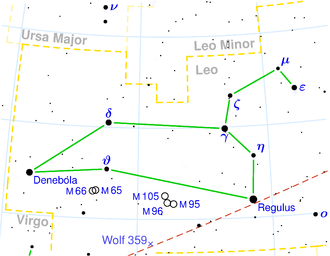NGC 3679
| Galaxy NGC 3679 |
|
|---|---|

|
|
| Shot with Pan-STARRS | |
| AladinLite | |
| Constellation | lion |
|
Position equinox : J2000.0 , epoch : J2000.0 |
|
| Right ascension | 11 h 21 m 48.0 s |
| declination | -05 ° 45 ′ 28 ″ |
| Appearance | |
| Morphological type | E1 / SA0- |
| Brightness (visual) | 13.6 mag |
| Brightness (B-band) | 14.6 mag |
| Angular expansion | 1 ′ × 0.8 ′ |
| Position angle | 80 ° |
| Surface brightness | 13.4 mag / arcmin² |
| Physical data | |
| Redshift | 0.028156 ± 0.000130 |
| Radial velocity | 8441 ± 39 km / s |
|
Stroke distance v rad / H 0 |
(371 ± 26) x 10 6 ly (113.7 ± 8.0) Mpc |
| history | |
| discovery | William Herschel |
| Discovery date | April 24, 1784 |
| Catalog names | |
| NGC 3679 • PGC 34844 • MCG -01-29-012 • 2MASX J11214807-0545274 • GC 2417 • H III 112 • GALEX ASC J112148.11-054526.6 • LDCE 803 NED004 | |
NGC 3679 is an elliptical galaxy from the Hubble type E2 in the constellation Leo on the ecliptic . It is estimated to be 371 million light years from the Milky Way and about 110,000 light years in diameter.
The object was discovered by Wilhelm Herschel on April 24, 1784 .
